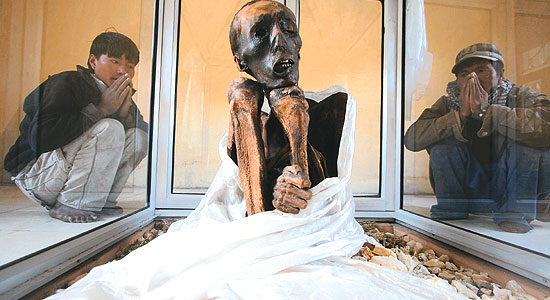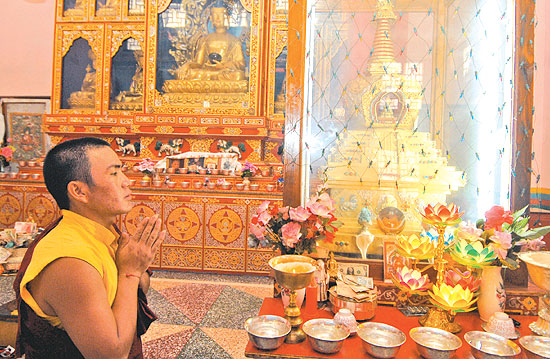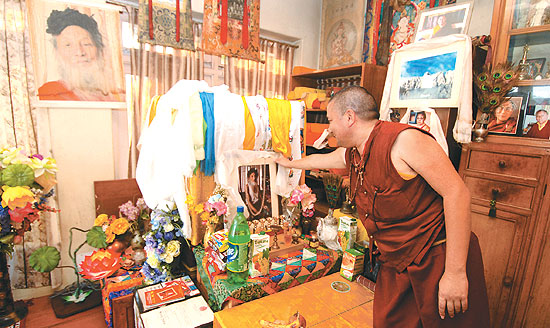
Shahrukh Khan of Gue: The sitting, ‘natural’ mummy of Tibetan monk Sangha Tenzin in a Spiti Valley village
Yoga Without End
They’re not sculpted deities, but the Tibetan monk mummies of Himachal are as venerated
A Guide To The Tibetan Mummy
- Almost all Tibetan mummies are preserved in the sitting rather than the reclining posture and housed in shrines called chortens or chokdens
- Most mummies are ‘natural’, preserved by cold and weather. They are mostly bodies of monks who’ve willed themselves to death
- For ‘non-natural’ mummies, clay or salt is used for preservation
***
Mountains are said to hide many a secret in their folds. Few, for instance, know of the ‘Shahrukh Khan’ of Gue village in the Spiti Valley of Himachal Pradesh. Shahrukh is the local police’s affectionate nickname for the village’s star attraction—the mummy of Tibetan monk Sangha Tenzin. The residents of this remote village offer prayers, perform rituals and read scriptures in front of the dead monk, frozen in an eternal squatting pose.There are many unconfirmed tales about the mummy—that it was accidentally discovered after an earthquake some 30 years ago, that Indo-Tibetan Border Police (ITBP) patrol officers hit upon it while digging bunkers, that villagers chanced upon it while repairing a road. Anyway, back then, its discovery is said to have terrified some locals, though not its playful kids, who are believed to have guilelessly pulled the hair of this well-preserved, 550-year-old mummy which had, and still has, its hair, nails and teeth intact.
Restricted and difficult public access to Gue, located in an ITBP-controlled area near the Indo-China border, ensured that ‘SRK’ remained away from the limelight for long. It was only recently that adventure tourists and a team of American anthropologists and scientists brought it into the media eye. Housed in a glass case, the mummy has now become the calling card of the far-flung village, its residents seeking government help for the protection, upkeep and preservation of their precious relic.

Well-urned: The silver stupa housing the heart of the eighth Khamtrul Rinpoche at the Khampagar monastery in Tashi Jong
Four years ago, a highly regarded meditation guru of Tashi Jong, Yogi Amtrin, passed away at the age of 84 and one of his disciples, Poppa Rinpoche, decided to conserve his body. The rest of the monastic community whole-heartedly approved. So a small shrine, up a steep hill behind the monastery, houses a wooden box in which Amtrin sits in the meditative lotus posture. It is a well-lit, airy room—he used to live in it—and is cheerfully decorated with bright plastic flowers and flags. Offerings of Tropicana mixed fruit juice, Britannia Digestive biscuits, fruits, Dabur honey and Sprite, are laid out invitingly, almost suggesting that the Yogi is about to partake of them.
There are about eight mummies in the Ladakh and Spiti valleys and one each in Dehradun & Kalimpong.
The media-shy and reticent Poppa is not too keen to talk, and seems visibly irritated with the growing media interest in the mummy and the resulting misinformation. “Some are writing that we are trying to bring the Yogi back to life. If we had such powers, why would we let anyone die?” he asks. Forty-one-year-old Poppa, who came to Tashi Jong when he was only eight, has preserved his guru’s body for only one reason. “He was a Tokden, a highly evolved meditation master who had reached out to his own mind through the practice of meditation,” he says. This was a man, he explains, who went into the mountains on the most rigorous of retreats, sometimes for as long as 10 years. Retaining his presence in the community’s midst will inspire his followers, his preserver believes. “He has not passed away, he will continue to guide us,” says Poppa fervently.
Unofficial estimates suggest that Yogi Amtrin and Sangha Tenzin are not the only Tibetan mummies in the mountains where Tibetan Buddhists live, and where their monasteries, some of great antiquity, exist. There are said to be about eight mummies in the monasteries of the Ladakh and Spiti valleys as well as one each in Kalimpong and Dehradun. Besides, there is also the present Dalai Lama’s tutor, Kyabje Yongdzin Ling Rinpoche, whose body was embalmed more than two decades ago and currently rests at the Tibetan leader’s residence in McLeodganj.
However, mummification is not a common Tibetan practice, as it was in ancient Egypt. Tibetans commonly offer their dead to the vultures and fishes, a practice driven by their love for animals. Cremation is reserved for the elite—probably because of the lack of wood in the higher reaches of mountains. The embalming of bodies is a gesture accorded to very few—the most venerable of teachers and high priests.

Sprite libation: The decorated shrine housing the mummy of Yogi Amtrin in Tashi Jong
Even in the case of “non-natural” mummies, Tibetans use natural elements like clay and salt for their preservation. Poppa has preserved Yogi Amtrin’s body with salt, which is supposed to remove moisture and hence prevent decay. To start with, the salt was changed every three days, then once a week. As the body began to dry up, however, it needed to be changed just once a month, Poppa explains. Now that the mummy is sufficiently dry, it is kept in a box filled to the brim with sand. The art of preservation can be more difficult than it seems. Amtrin passed away in the monsoons, the season of high humidity. “I was worried that the weather might prevent the body from drying up,” recalls Poppa. “But my apprehensions were proven wrong,” he says with a smile.
Quite obviously, his act was driven by unquestioning faith and devotion. This sense of commitment, underpinned by a strong belief system, is evident in the entire community. You can hear it in the deafening hush of the temples, in the circling prayer wheels, even in the monastery’s nods to modernity. Smoke on the Water might blare out of Tashi Jong’s sole Internet cafe, but the screensaver on every computer is a picture of the current head of the monastery, the ninth Khamtrul Rinpoche.
Clearly then, this is a world poised between the scientific and the mystical, the rational and the irrational. You are caught between the twin pulls of belief and disbelief as you are told one story after another. Or are shown the silver stupa, built with donations from the Queen Mother of Bhutan, which houses the heart of the eighth Khamtrul Rinpoche. Legend has it that his heart remained intact despite his body being cremated. Another stupa, which houses his bones, ashes and relics, has a Bodhi tree said to have sprung up on its own above the head of a Buddha statue. “Foreigners are completely confounded by this tree,” smiles Thinley Namgyal, from Kinnaur, who is studying to be a monk.
Poppa has bigger plans for Yogi Amtrin than having him stay on in his room. A spacious meditation hall is being built, and this is where Amtrin’s body will eventually be seated, in a glass box. It’s a room with stunning views, the green and picturesque Kangra valley spread out on one side and the majestic hills framing it from behind. The best resting place any mummy could ask for.
Forwarded by forum member Tejwant Singh by private email message.

